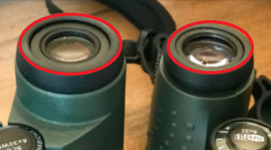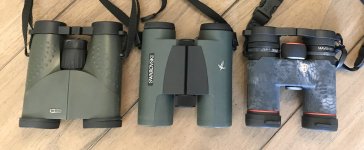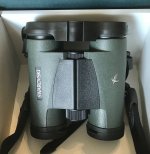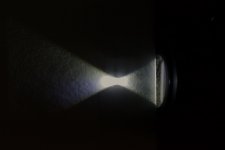-
Welcome to BirdForum, the internet's largest birding community with thousands of members from all over the world. The forums are dedicated to wild birds, birding, binoculars and equipment and all that goes with it.
Please register for an account to take part in the discussions in the forum, post your pictures in the gallery and more.
You are using an out of date browser. It may not display this or other websites correctly.
You should upgrade or use an alternative browser.
You should upgrade or use an alternative browser.
Swarovski 8x30 SLC NEU vs Zeiss 8x30B T* Dialyt (1 Viewer)
- Thread starter gcole
- Start date
More options
Who Replied?eitanaltman
Well-known member
If I'd owned the mark III (neu) I would probably not have purchased the 8x32 FL I replaced the mark II with.
Nitpick #1 - I believe the Neu is the fourth iteration, not third?
I also noticed the Swarovski ocular eye lens diameter are smaller, so no more of you Meopta bashers complaining of their small ocular lens.
Nitpick #2 - the issue with the little Meostar isn't the ocular lens diameter, it's the EYECUP diameter. Your photo ironically illustrated the problem well -- hotice how much larger the outer rim of the lip of the eyecup is on the SLC. On the Meostar, the barrel tapers slightly at ocular end, and then additionally the eyecups themselves are narrower than the barrel and also taper a bit. They could easily make the Meopta eyecups wider diameter without looking aesthetically awkward (as the SLC does):

If the 32mm Meostar had eyecup diameters like the SLC on the left, I'd probably still own them!
Enjoyed your review and comparison, and not surprised these are optically within spitting distance of each other. Both top notch Euro glass with great clarity and just a notch down from the very best.
I completely agree with this. I really like the quirky looks, the size, shape and form/grip factor of the little Meostar. Mine was an earlier model which had a warmer/yellower hue to the view, but I sent them to Meopta to fix the focus wheel and I'm pretty sure they did something, because not only the focus was changed, so was the rubber armour and I could swear the image was less warm. It was sharp and full of contrast, really immersive and sweet, but those eyecups... I can't remember whether the eyecups on the Meostar are removable, but they are in most top models*, I simply can't understand why don't they offer at least two withs. They have the thread model, it's just about making a set of two rubber eyecups and attach them to whatever material the skeleton of the eyecup is made of. Swarovski does it with the Habicht, even if it's not on purpose, but the GA and the regular black/leatherette version offer two eyecups, and one is distinctively wider.... The issue with the little Meostar isn't the ocular lens diameter, it's the EYECUP diameter.... If the 32mm Meostar had eyecup diameters like the SLC on the left, I'd probably still own them!
*Even lower-middle class models like the Traveler ED 8x32 has removable eyecups these days.
eitanaltman
Well-known member
Yes the Meostar eyecups screw off.
Nitpick #1 - I believe the Neu is the fourth iteration, not third?
Nitpick #2 - the issue with the little Meostar isn't the ocular lens diameter, it's the EYECUP diameter. Your photo ironically illustrated the problem well -- hotice how much larger the outer rim of the lip of the eyecup is on the SLC. On the Meostar, the barrel tapers slightly at ocular end, and then additionally the eyecups themselves are narrower than the barrel and also taper a bit. They could easily make the Meopta eyecups wider diameter without looking aesthetically awkward (as the SLC does):
View attachment 1366139
If the 32mm Meostar had eyecup diameters like the SLC on the left, I'd probably still own them!
Enjoyed your review and comparison, and not surprised these are optically within spitting distance of each other. Both top notch Euro glass with great clarity and just a notch down from the very best.
Thanks. I spent another 15 minutes today comparing the Meostar to the Swarovski viewing off of our lanai(our screened-porch) this afternoon. The more I use the Swarovski 8x30 SLC Neu, the more I am appreciating them. As I said earlier, the view provided to my eyes between the two are pretty much equal. The Swarovski NEU focus wheel placement due to their backend focus wheel design is the only thing I would change if I could.
Last edited:
If I could choose between a center focus wheel binocular or this SLC NEU back end design, I definitely would choose the center focus but the more I use them the easier it gets when it comes to adjusting to their focus wheel. Would this be a deal breaker if these were the only binoculars for me to use ?, no .... but for me personally if I could send them back to Swarovski for a center focus wheel re-fit I would. The 8x30 SLC NEU gives a very nice view, is very well built and has that Quality look that the Swarovski brand is known for. It’s for these reasons it is a keeper, the focus wheel design I can adapt to.Gwen,
I want to know how you get along with the focus adjustment on the far end of the hinge?
Last edited:
james holdsworth
Consulting Biologist
My 7x36 Bausch and Lomb Elite has the objective end focus and I find it quite troublesome in the field, with my fingers hanging out in front of the objectives.....didn’t have the same problem with my 10x42 Elites as the longer barrels gave my fingers a place to rest.
Gijs van Ginkel
Well-known member
I never had problems with the position of the fOcusser on my SLC 8x30 NEU.
Gijs van Ginkel
Gijs van Ginkel
I have read other user opinions on other sites where the 8x30 SLC NEU, along with the earlier versions of the SLC WB 8x30 with their owners not only had no problem with the backend focuser but actually liked the focus design. These sites were not Birding forums, but for other outdoor wildlife viewing where their Surveillance of outdoor terrain/animals were either stationary or very slow moving. This brings me back to wonder why the Swarovski engineers decided to use this type of focusing system and to keep it in this particular 30mm roof prism design for so long .... does this design make them a more water tight/proof and or a more knock around bullet proof binocular over the center focus roof prism binoculars at that time ? Below are the only two other roof prism binoculars I now use. The Meopta Meostar 8x32 mentioned earlier and a Custom Maven 6x30. Both very well built but if I were to bet which one would survive a nasty roll down a steep mountain side my money would be on the Swarovski.I never had problems with the position of the fOcusser on my SLC 8x30 NEU.
Gijs van Ginkel
Attachments
Last edited:
eitanaltman post #22,
You mention eyelens diameter . After reading through this thread and playing with my Nikon MHG 8x42 it got me thinking . The MHG has a huge eyelens imo . To me it seems most of the eyelens is unusable with exception to the exit pupil it projects . Why such a big lens ? I know I must be missing something here .I tried to adapt to the Swarovski SLC 8x30 NEU backend focuser. I really wanted to keep it, knowingI I would probably never find another in such pristine condition. If the Swarovski 8x30 SLC NEU had a upfront focuser I would not have sold it. Sold today to a member here.I have read other user opinions on other sites where the 8x30 SLC NEU, along with the earlier versions of the SLC WB 8x30 with their owners not only had no problem with the backend focuser but actually liked the focus design. These sites were not Birding forums, but for other outdoor wildlife viewing where their Surveillance of outdoor terrain/animals were either stationary or very slow moving. This brings me back to wonder why the Swarovski engineers decided to use this type of focusing system and to keep it in this particular 30mm roof prism design for so long .... does this design make them a more water tight/proof and or a more knock around bullet proof binocular over the center focus roof prism binoculars at that time ? Below are the only two other roof prism binoculars I now use. The Meopta Meostar 8x32 mentioned earlier and a Custom Maven 6x30. Both very well built but if I were to bet which one would survive a nasty roll down a steep mountain side my money would be on the Swarovski.
Attachments
tenex
reality-based
I asked this question once myself but can't find the thread... look for a ray diagram. A large lens is required to provide a wide AFOV from 15-20mm away, the kind of eye relief demanded today. As you bring it closer to your eye you really wind up using all that glass to see the whole field, not just the central bit where you see the exit pupil from farther away, which is a simple function of aperture and magnification. We have a 72° eyepiece of 5mm focal length on our scope now, whose exit pupil (at 88x) is just under 1mm, which looks quite silly on a lens 35mm in diameter... until you start using it.After reading through this thread and playing with my Nikon MHG 8x42 it got me thinking . The MHG has a huge eyelens imo . To me it seems most of the eyelens is unusable with exception to the exit pupil it projects . Why such a big lens ? I know I must be missing something here .
Last edited:
james holdsworth
Consulting Biologist
Something like the FL 7x42 doesn’t have a large ocular lens but has a wide field...
tenex
reality-based
The apparent field of FL 7x42 must be about 60°, which can just be considered wide-angle, and its ER of 16mm is also on the low end of what eyeglass wearers today might consider acceptable. So perhaps someone who understands optics better than I can explain how it does even that well without a larger ocular? (And while I haven't seen one, I presume it has similar peripheral aberrations to the other FLs... a sign of how the ocular design is being pushed?)
henry link
Well-known member
Here's a photo I just made of light emerging from the eyepiece of a binocular (Nikon 8x32 SE). You can see that light from the edges of the eye lens emerges at an angle and becomes concentrated at the the eye relief distance where the exit pupil forms, resulting in an hourglass shape as the rays cross at the exit pupil. The slopes of the sides of the light emerging from the eye lens form a cone with an angle that corresponds to the AFOV, a base equal to the eye lens diameter and a height equal to the eye relief distance.
Attachments
Last edited:
Users who are viewing this thread
Total: 2 (members: 0, guests: 2)







